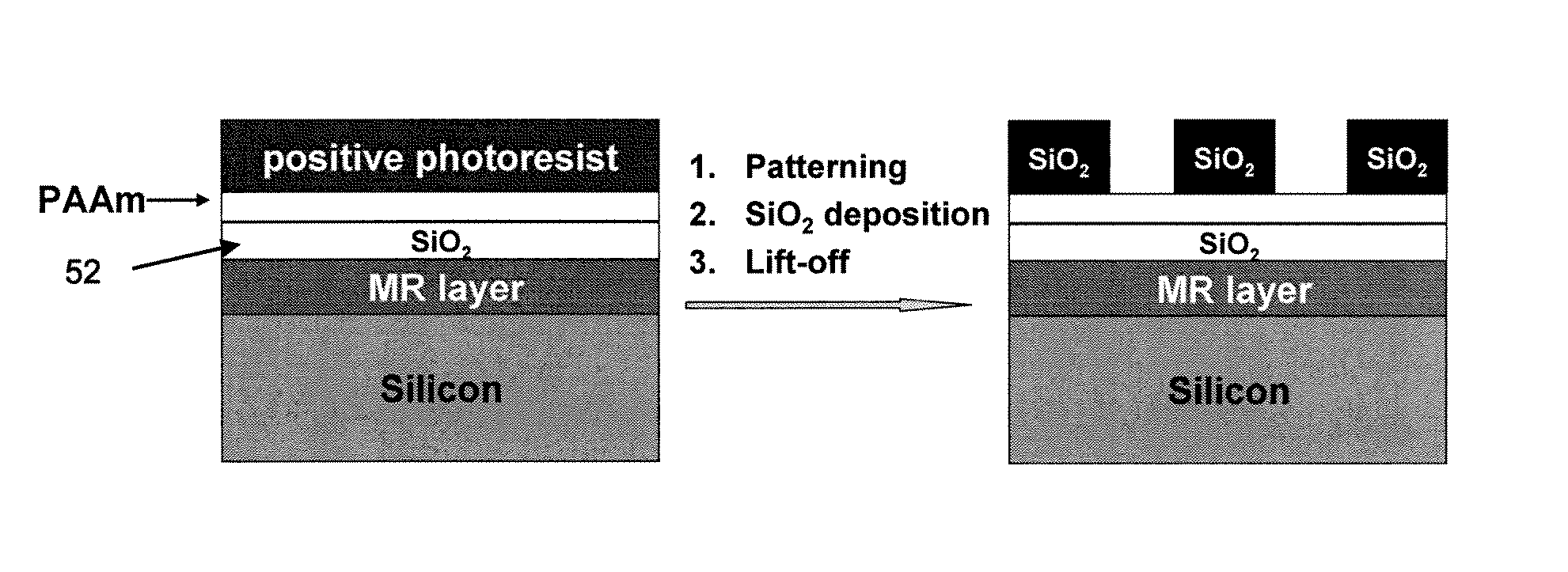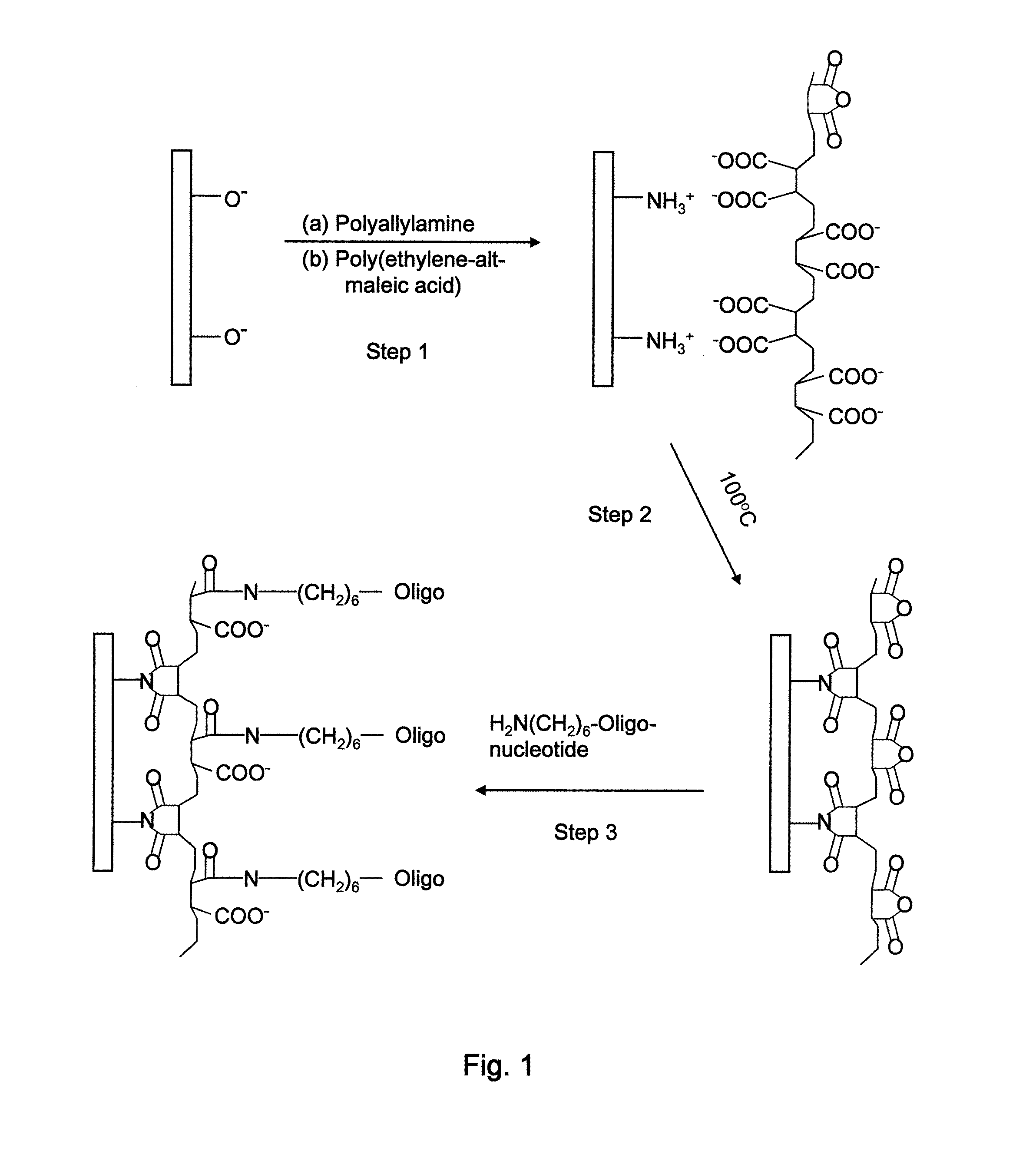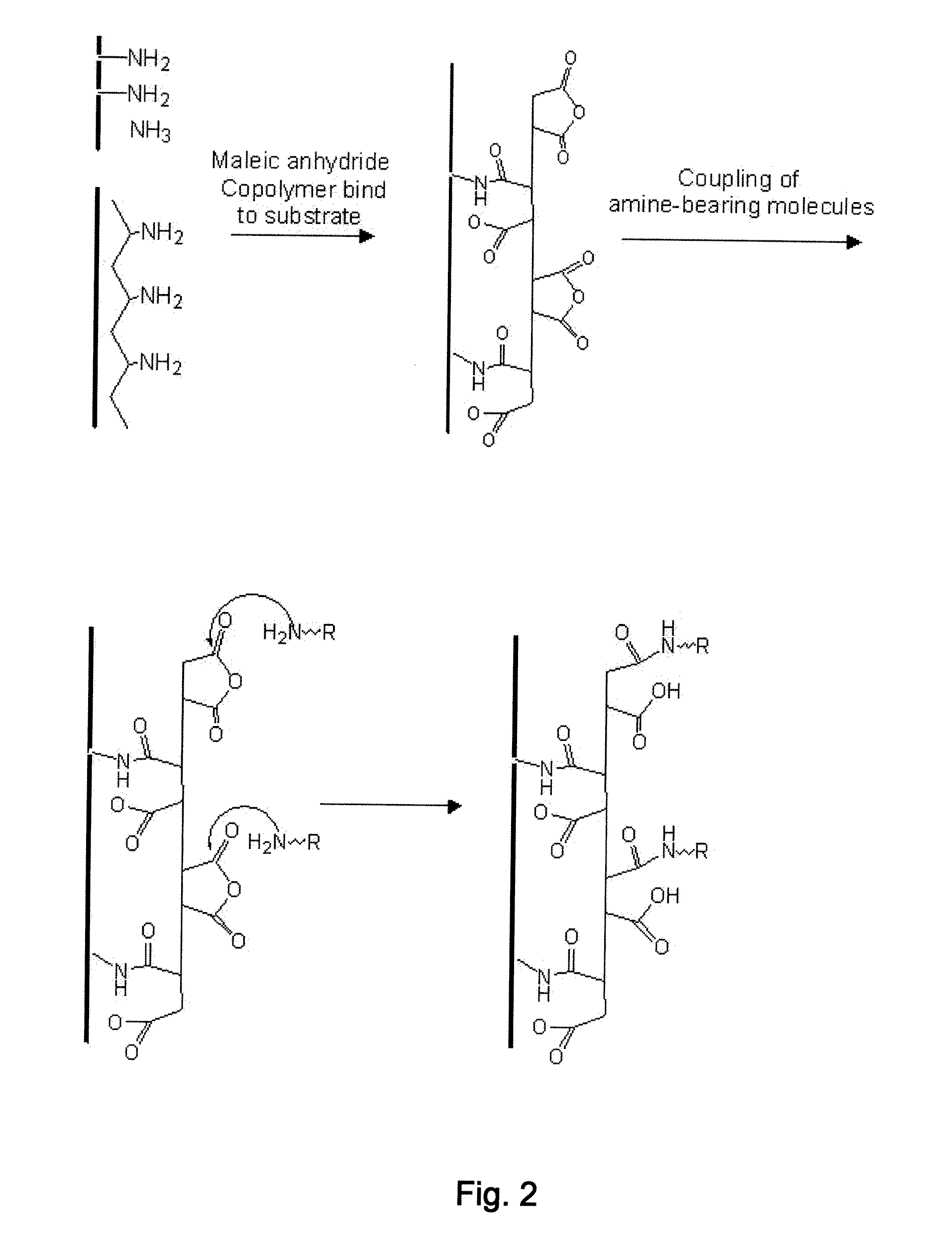Biomolecule Immobilization on Biosensors
a biosensor and biomolecule technology, applied in the field of surface modification of a substrate, can solve the problems of requiring covalent interaction between substrate and probe, generally negatively charged glass, and strong attachmen
- Summary
- Abstract
- Description
- Claims
- Application Information
AI Technical Summary
Benefits of technology
Problems solved by technology
Method used
Image
Examples
example 1
Chip Fabrication
[0078]As shown in FIG. 5, a silicon substrate containing an MR (magnetoresistance) layer was prepared as a spin valve. Spin valve magnetic sensors were fabricated from 4-inch silicon wafers containing layers Si / Ta 3 nm / seed layer 4 nm / PtMn 15 nm / Co90Fe10 2 nm / Ru 0.85 nm / Co90Fe10 2 nm / Cu 2.3 nm / Co90Fe10 2 nm / Cu 1 nm / Ta 4 nm with a magnetoresistance (MR) of 10.3% and a sheet resistance of 18.41Ω. Next, a silicon oxide layer 52 was added by sputter coating. This serves as a passivation layer and may be about 10-20 nm thick. Other passivation layers (e.g., silicon nitride or a combination of silicon oxide and silicon nitride) may be used.
[0079]Next, the prepared substrate having a thin SiO2 passivation layer was coated with polyallylamine (PAAm) and heated at 170° C. for 2 min. A whole wafer was coated with PAAm by immersing the wafer into a 2 wt % PAAm in water solution for 30 seconds, rinsing with water, and blowing dry. The thickness of the polymer film was characteri...
example 2
Hybridization Assays
[0085]Target hybridization was performed at room temperature under 100% humidity overnight in MES buffer (0.1 MES, 0.9M NaCl, pH 6.5). The chip was then rinsed with PBS buffer containing 0.01% Tween 20 three times, each for 1 min and finally blown dry with argon.
[0086]The general assay format for the present work is shown in FIG. 3(G). The probe is the oligo as shown in FIG. 1, attached to a substrate. The target DNA, if complementary, will bind to the probe, and bears a biotin label. This label is in turn tagged with a streptavidin-coated magnetic nanoparticle.
[0087]Hybridization assays were conducted on a duplex microarray (i.e., having two complete sets of probes) to demonstrate the performance of the present surface chemistry. Solutions of positive and control oligonucleotide probes bearing amino groups on the 5′-end were manually spotted to different sensors on the same chip following surface activation. The sensors were then blocked with ethanolamine and hy...
example 3
Magnetic Sensor Measurements
[0089]The success of the surface chemistry was further confirmed by real-time measurement of magnetic sensors. The two positive sensors were coated with 5′-5AmMC6 / TTT TTT TTT TCT ACC AAT CCA CAA ATA CCC ATC TAC CAT A-3′ (SEQ ID NO:4) probes, while the two control probes were coated with 5′-5AmMC6 / TTT TTT TTT-3′ (SEQ ID NO:2) probes. The positive probe sequence listed here can be seen to have a poly T spacer which will be adjacent the substrate and provides space for hybridization without interference by the substrate. The notation 5AmMC6 refers to a six-carbon linker and an amino group attached to the end. The DNA target used for hybridization was biotin5 / 5Biotin / TAT GGT AGA TCC GTA TTT GTG TTT GTG GAT TGG-3 (SEQ ID NO: 3) at a concentration of 10 nM. 5 / 5Biotin means that the biotin is attached to the 5′ end of the oligo.
[0090]FIG. 4(A) shows a real time response of sensors by applying magnetic nanoparticle solution to a chip having hybridized with target...
PUM
| Property | Measurement | Unit |
|---|---|---|
| temperature | aaaaa | aaaaa |
| temperature | aaaaa | aaaaa |
| temperature | aaaaa | aaaaa |
Abstract
Description
Claims
Application Information
 Login to View More
Login to View More - R&D
- Intellectual Property
- Life Sciences
- Materials
- Tech Scout
- Unparalleled Data Quality
- Higher Quality Content
- 60% Fewer Hallucinations
Browse by: Latest US Patents, China's latest patents, Technical Efficacy Thesaurus, Application Domain, Technology Topic, Popular Technical Reports.
© 2025 PatSnap. All rights reserved.Legal|Privacy policy|Modern Slavery Act Transparency Statement|Sitemap|About US| Contact US: help@patsnap.com



